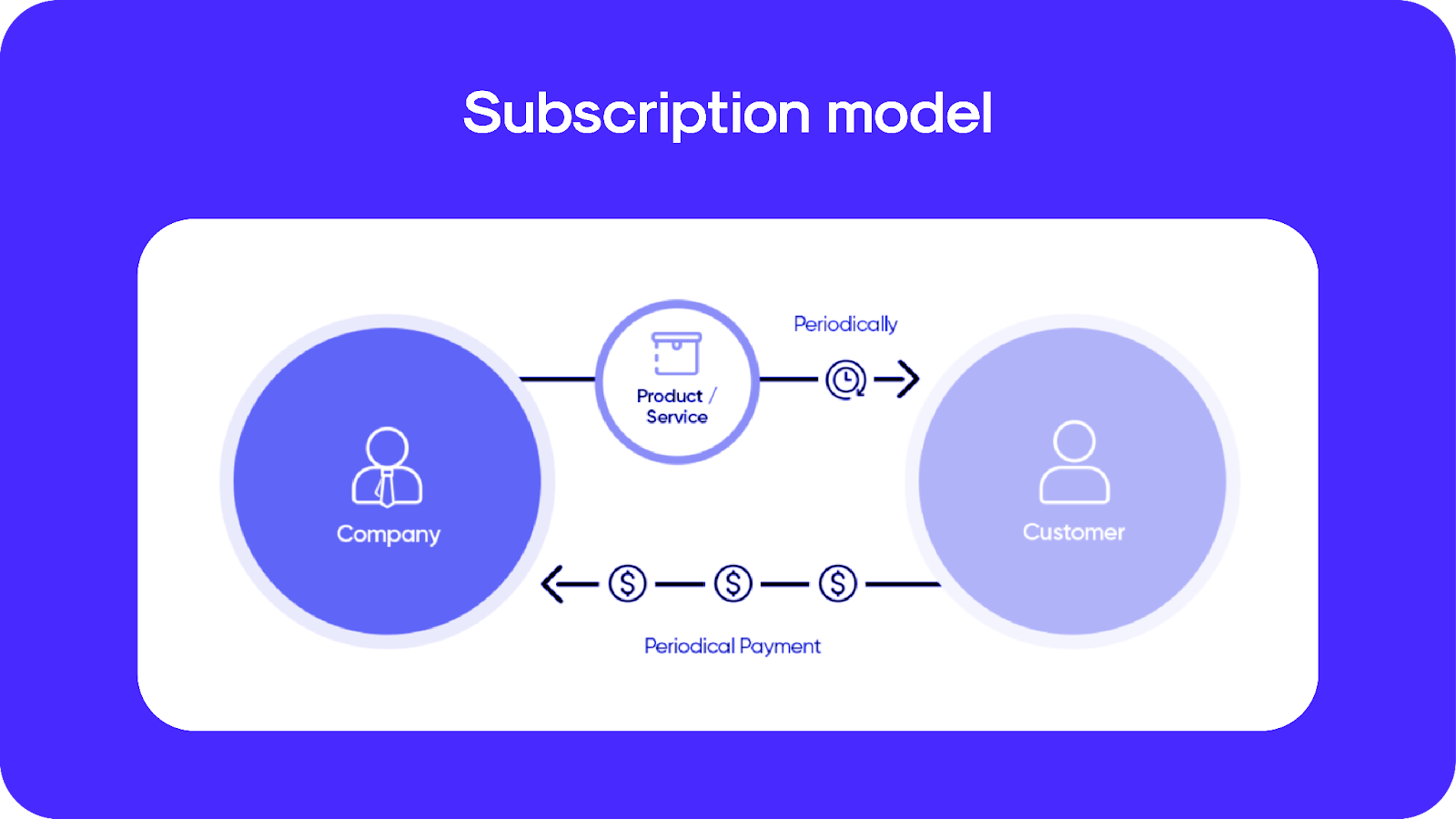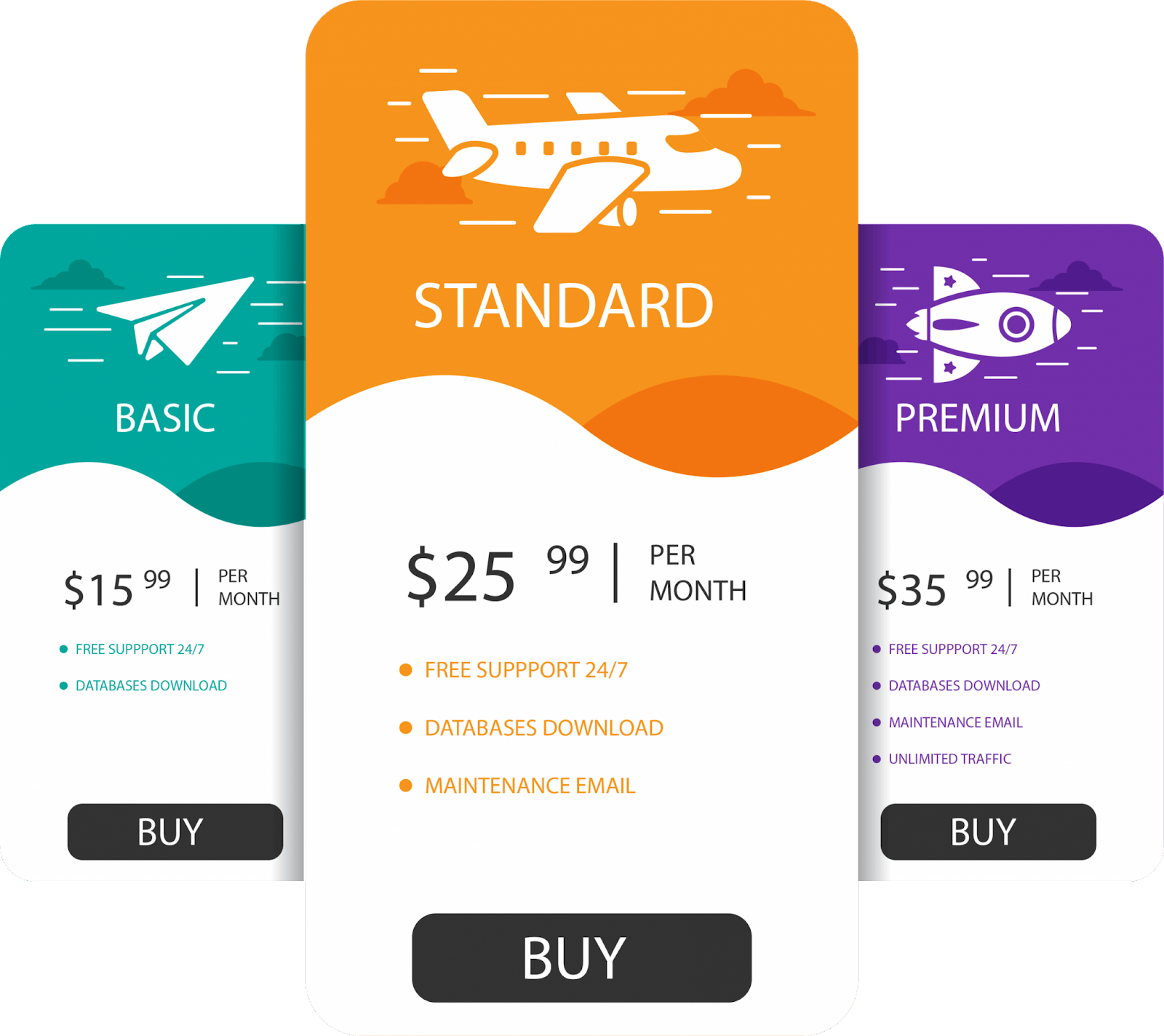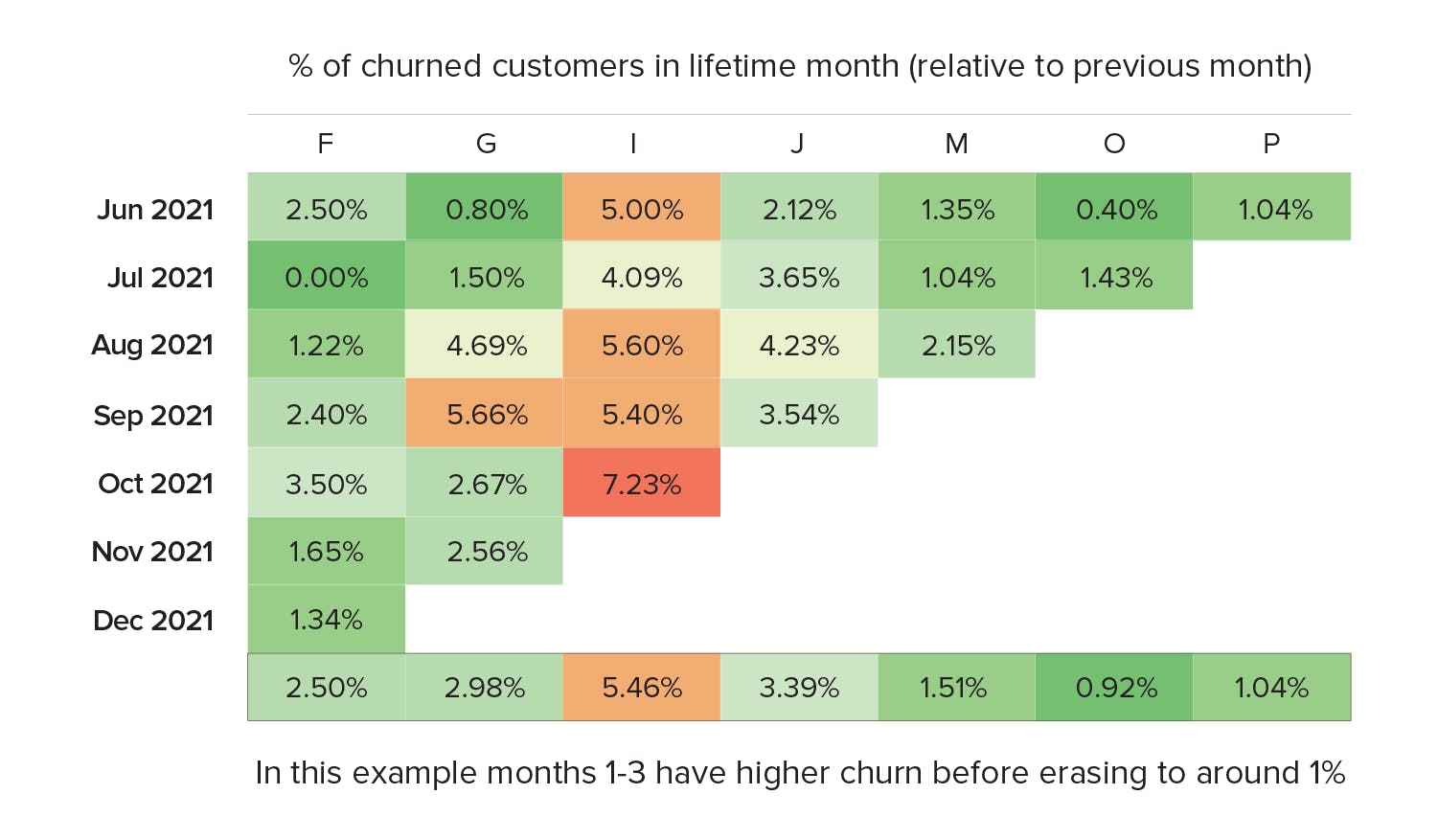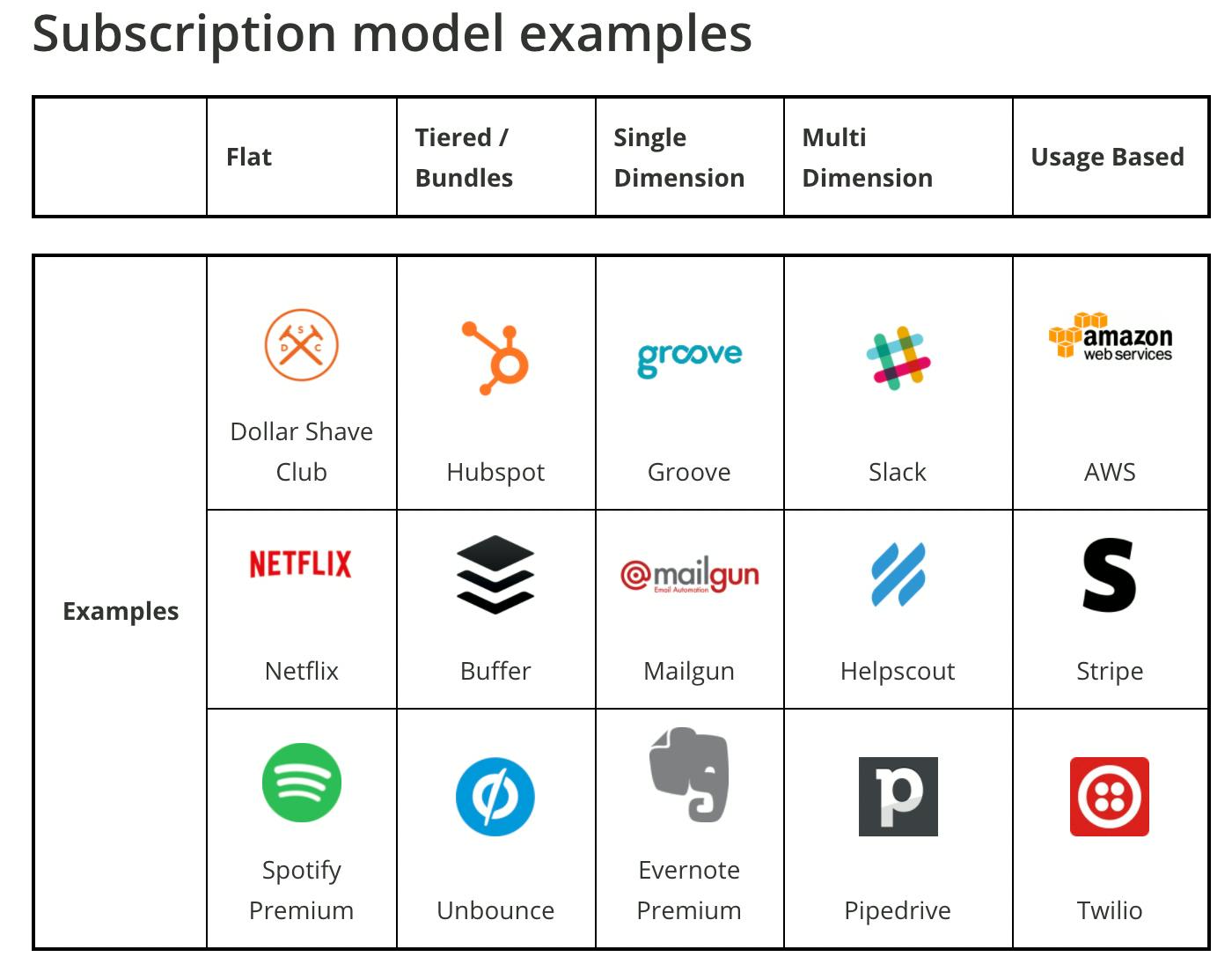Subscription business model: how-to, examples and key metrics
Nov 2nd, 2023

Contents
What is a subscription business model?
How to develop a subscription business model?
Key metrics for subscription businesses
Examples of subscription businesses
Nowadays, consumers seek personalized, seamless, and adaptable products and services. The subscription business model effectively caters to this demand by offering services that satisfy diverse client requirements. There are examples of such models in almost every industry, from meal kits to streaming services, and companies are constantly experimenting with new methods to enhance customer acquisition and retention initiatives.
According to studies, the subscription e-commerce sector is anticipated to grow from $15 billion in 2019 to over $450 billion by 2025. These prospects for growth provide intriguing opportunities for existing and potential business owners. In this article, we will explain how to develop a subscription business model, discuss crucial metrics that the owners of the product should track, and provide some examples of subscription businesses.
What is a subscription business model?
Subscription business model is a strategic approach that companies employ to offer their products or services to customers regularly, typically for a period such as a month or a year, in exchange for a standard fee. This model has gained significant popularity across various industries, including entertainment, software, and consumer goods, because of its potential to create stable and predictable revenue streams while fostering long-lasting relationships with customers.
From a consumer perspective, subscription services offer convenience, as they provide regular access to products without the need for repetitive purchasing decisions. Moreover, the model emphasizes personalization and often incorporates elements of customer engagement, such as updates, support, and regular improvements to maintain subscriber interest.

By establishing a continuous relationship with customers, companies can gather data on usage patterns, preferences, and behaviors, enabling them to tailor offerings and marketing strategies more effectively. Businesses can better forecast their earnings, allowing for more effective financial planning and resource allocation. Additionally, the model encourages customer retention and loyalty, as subscribers tend to be more invested in the service and less likely to switch to competitors.
However, the success of a subscription business model depends heavily on delivering consistent value and maintaining customer satisfaction. Companies must continuously innovate and improve their offerings to prevent subscriber churn and keep their services relevant in a competitive market.
How to develop a subscription business model?
Developing a subscription model is similar to a business planning process. It requires preliminary research, thorough analysis, identifying your customer needs, and testing. Here are seven essential steps that will help you complete this task.
Step 1. Conduct market research
Before developing a subscription business model for your company, it is crucial to make sure that it aligns with the nature of your products and services. Consider whether your offerings demand continuous access. Software products, ongoing services like consulting, and exclusive media fall within this category. Moreover, a subscription model could also be applicable if your product requires periodic replenishment, such as day-to-day items, books, or snacks.
Conducting comprehensive market research becomes vital at this stage. To transform your product into a sustainable subscription plan, you need to identify your target audience. Even if you have an existing customer base, you should determine who would prefer your offering over a traditional purchase. Therefore, it is critical to understand your customers’ needs and challenges. The task may often require you to engage a market research analyst or a team of analysts to help you process multiple data points.
Once you determine their demands and difficulties, you need to turn the solution into a prolonged service. It goes beyond resolving a single issue. Instead, you commit to delivering value consistently over extended periods from weeks to months and even years. You can use surveys, interviews, and online research to gather insights into what problems your subscription service could solve and how it can stand out from existing solutions.
Step 2. Analyze the competition
The following step in developing a subscription business model is to conduct an in-depth analysis of your rivals. You might already have some competitors in mind, or you might need to perform research to gain a clearer understanding of your opponents.
To shape a subscription model, your focus should be on identifying opportunities to outperform the competition. These opportunities may revolve around the product and its features, offering top-notch and immediate customer service or even a more appealing pricing structure. Examine your competitors to determine effective strategies and essential components for selling subscriptions within your industry.
Step 3. Define your value proposition
Clearly articulate the unique value your subscription service will provide. What makes it different from other offerings in the market? Highlight the specific benefits customers will receive by subscribing. Whether it's convenience, cost savings, access to exclusive content, or personalized experiences, your value proposition should appeal to your target audience.
Address pain points or challenges faced by your customers. By solving these problems, you position your service as an offering that directly caters to their needs. Whenever possible, provide examples or success stories that demonstrate the positive outcomes customers can achieve through your subscription service. It adds credibility and helps consumers visualize the value they'll receive.
Consider the various segments within your target audience and tailor your value proposition to each group's specific needs and preferences. Different customer segments prioritize distinct aspects of your offering. Run surveys or A/B tests to compare different versions of your value proposition.
Step 4. Set a pricing strategy
Create a pricing strategy that reflects the value you're offering and allows you to remain competitive in the market. Consider factors such as production costs, customer acquisition expenses, and the perceived value to customers. You can choose from various pricing models, such as flat-rate subscriptions, tiered pricing, or usage-based fees. Your pricing should cover costs and enable healthy profit margins to sustain and grow your business.
To attract a desired audience, you can start by implementing the freemium model or offering subscriptions at discounted prices (applying a form of penetration pricing). This strategy encourages customers to sign up for the service, increases consumer engagement, and introduces the product’s features and advantages.

Arriving at the optimal balance between pricing and features is unlikely to be a one-time decision. You must experiment with various price points and features to determine what resonates with customers and leads to conversions. Even after identifying a successful formula, you must periodically revise it as you introduce new updates, broaden your services, or establish additional subscription tiers.
Step 5. Develop a marketing plan to attract customers
Create a comprehensive growth marketing strategy to attract your initial subscribers. Utilize a mix of digital marketing, social media, content creation, and influencer partnerships to spread awareness about your subscription service. Craft compelling messaging that communicates the benefits of subscribing.
To create a solid online presence, begin by leveraging digital marketing channels such as social media platforms, search engine optimization, and content marketing. Craft compelling, relatable content that showcases your value proposition and resonates with your target audience's pain points and aspirations.
Engage in influencer collaborations and partnerships within your industry to tap into existing audiences that align with your subscriber base. Employ email marketing campaigns to nurture leads and keep existing subscribers informed and engaged with updates, exclusive offers, and valuable insights. Additionally, consider utilizing paid advertising campaigns on platforms like Google Ads or social media to enhance your reach and capture the attention of potential subscribers.
Step 6. Gather feedback to refine your offering
Regularly gather feedback from your subscribers through surveys, reviews, and direct interactions to gain insights into their evolving needs and preferences. Iterate your subscription packages, content, and features based on customer demands and changing market trends. Cultivate a community around your subscription service through personalized communication, exclusive content, and customer support. Building and maintaining strong relationships with your subscribers will be critical to the long-term success of your subscription business.
Furthermore, monitor key performance metrics related to customer engagement, churn rates, and subscription renewals to gauge the overall health of your business. Analyze this data to identify trends, patterns, and potential pain points that need addressing. By proactively solving issues and adapting to your customers' changing expectations, you'll retain your existing subscribers and attract new ones.
Step 7. Prepare a business growth plan
As your subscription business evolves, the focus shifts towards scalability and innovation. This step entails planning for future growth while consistently introducing new ideas to keep your offerings relevant and captivating.
Firstly, assess your operational infrastructure to ensure it can handle increased demand as your subscriber base expands. Scalability involves anticipating higher volumes of orders, inquiries, and potential technical challenges. Implement efficient systems, robust customer support processes, and scalable technology solutions to accommodate growth seamlessly.
Secondly, prioritize innovation to maintain your competitive edge. Regularly assess the market landscape, staying attuned to emerging trends and technologies that could enhance your subscription service. Experiment with new features, product variations, or complementary services to provide added value to your subscribers. Encourage a culture of innovation within your team and cultivate an environment where creativity flourishes.
Following these steps, you can lay a strong foundation for your first subscription business and drive growth, customer loyalty, and sustainable revenue streams.
Key metrics for subscription businesses
Now, we will present five essential metrics to take into account if your goal is to create a successful subscription business.
Monthly recurring revenue
This metric is an excellent indicator of revenue growth or decline. It also helps forecast earnings you would bring in a year. By calculating MRR, you gain a clear understanding of your base revenue that can be relied upon to cover operational costs and invest in improvements.
MRR assesses the overall monthly revenue that a company receives from active subscribers. You can calculate it by multiplying the number of monthly users by the average revenue per customer:
MRR = number of users per month * average billed amount
When calculating MRR for subscribers under annual plans, the plan price is divided by 12, and the result is multiplied by the number of consumers on the yearly plan.
Churn rate
The churn rate is the proportion of consumers that cancel a subscription within a given period. You can calculate monthly, quarterly, or annual churn rates. If this number is high, it might indicate that you should make some significant changes.
To measure the churn rate, follow these steps. First, choose a specific time frame, like a month or a quarter. Count the number of clients at the beginning of the period (B) and then identify how many users have canceled their subscriptions during the same period (C). Then divide the cancellations (C) by the number of clients at the start (B), and multiply by 100:
Churn Rate = (C / B) * 100
A lower churn rate indicates better consumer retention and business health, while a higher rate suggests areas for improvement in your subscription offering or customer service strategies.

Customer lifetime value
CLTV is the predicted revenue a subscriber brings throughout their relationship with your business. It considers factors like subscription duration, average transaction value, and retention rate. Maximizing CLTV involves increasing customer loyalty, encouraging upsells, and enhancing the overall customer experience.
The simplest way to determine customer lifetime value is to divide the average monthly recurring revenue per consumer by the churn rate per month:
CLTV = (MRR / Monthly Churn Rate)
This calculation provides insights into how much revenue a customer will likely generate during their subscription period, helping businesses make better decisions about marketing strategies.
Customer acquisition cost
CAC represents the cost of acquiring a new consumer. It includes marketing expenses, sales costs, and other related expenditures. Keeping CAC in check is crucial to ensure that the cost of attracting new subscribers doesn't outweigh the revenue they bring in. A healthy business aims for a CAC that's lower than the customer lifetime value.
To calculate CAC, begin by summing up all expenses related to customer acquisition, including marketing costs, advertising expenses, sales team salaries, and any other associated costs. Next, count the number of new clients acquired within a given time frame. Divide the total acquisition costs by the number of new subscribers:
CAC = Total Cost of Sales and Marketing / Number of New Clients Acquired
A lower CAC relative to the Customer Lifetime Value (CLTV) indicates a healthier acquisition approach and potential for profitable growth.
Average revenue per user
ARPU estimates the average amount of revenue generated per consumer. It's a crucial metric for understanding the revenue potential of your customer base. ARPU can be broken down further by different subscription tiers or plans to identify which segments contribute most to your earnings. You can estimate the average revenue per customer by using the following formula:
ARPU = Total Revenue / Total Number of Subscribers
ARPU can be used to evaluate the effectiveness of pricing strategies, upselling efforts, and overall business performance.
These metrics provide insights into customer behavior, earnings, and overall business sustainability.
Examples of subscription businesses
We have selected five examples of well-known companies that can help you gain ideas on implementing the subscription model for your business.
Adobe
Adobe’s customers have an opportunity to buy each of its programs separately or subscribe for access to more than 20 applications, including Photoshop, Illustrator, and Premier Pro. This subscription, priced at $54.99 per month, not only offers an extensive suite of tools but also includes 100GB of cloud storage. Before their credit card is charged, prospective clients can sign up for a free 7-day trial.
Scribd
With Scribd, customers get unrestricted access to more than 60 million documents, including books, essays, and audiobooks on the e-book platform. As long as the customer's membership is active, content can be downloaded to the Scribd app for offline usage. Before charging $11.99 per month, Scribd offers a free 30-day trial without the ability to download.

Amazon Prime
Amazon Prime members pay a monthly or yearly subscription in exchange for benefits like free shipping, same-day food delivery, and unlimited access to digital content. In addition, Amazon Prime offers subscribers access to Prime Music, an ad-free music streaming service, and Prime Reading, allowing them to borrow e-books, magazines, and more from a diverse selection. The subscription includes features like early access to certain deals and promotions on the Amazon website, as well as unlimited photo storage through Amazon Photos.
Apple One
Apple One is a subscription bundle that offers customers a collection of the company's services in a unified package. With varying tiers, Apple One encompasses Apple Music for streaming, Apple TV+ for original shows, Apple Arcade for gaming, and iCloud storage for data backup and sharing. This subscription model allows users to access multiple Apple services under a single subscription, potentially leading to cost savings compared to purchasing each service individually.
Falck
Falck offers individuals and businesses emergency medical assistance, healthcare solutions, and safety services. Through their subscription model, customers can access a range of services designed to ensure their safety and well-being. These include emergency medical response, ambulance transportation, remote healthcare consultations, and preventive health programs.
The advantages of the subscription business model include predictable income, recurring revenue, stronger relationships with consumers, increased customer loyalty, and more opportunities for upselling and cross-selling. Moreover, this strategy is beneficial both for businesses and customers as it provides a perfect balance between price and value. Consumers receive the product immediately or get quick access to new features, while companies benefit from a more reliable income stream.
